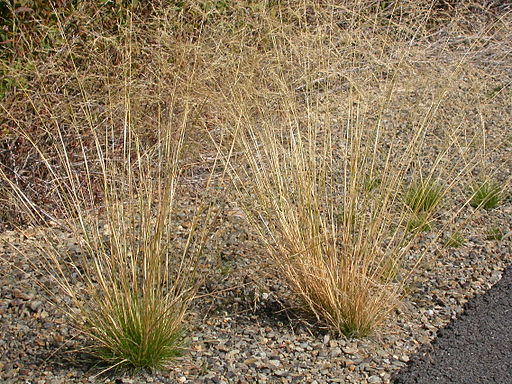Classification System: APG IV
Superregnum: Eukaryota
Regnum: Plantae
Cladus: Angiosperms
Cladus: Monocots
Cladus: Commelinids
Ordo: Poales
Familia: Poaceae
Subfamilia: Pooideae
Tribus: Aveneae
Subtribus: Agrostidinae
Genus: Agrostis
Species: Agrostis scabra
Name
Agrostis scabra Willd.
References
USDA, NRCS. 2006. The PLANTS Database, 6 March 2006 (http://plants.usda.gov). Data compiled from various sources by Mark W. Skinner. National Plant Data Center, Baton Rouge, LA 70874-4490 USA.
Vernacular names
suomi: Rikkarölli
Agrostis scabra is a common species of grass known by the common names hair grass,[2] rough bent,[3] rough bent grass,[2] winter bent grass,[2] and ticklegrass.[4] A tumbleweed,[4][5] it is a bunchgrass native to Asia and much of North America, and widely known elsewhere as an introduced species.
Distribution
It occurs in most of the United States except parts of the Southeast and most of Canada except for the farthest northern regions. It can be found in Mexico and California, and across Alaska to far eastern Asia as far south as Korea.[6]
It is resident in a great variety of habitats, from warm coastal valleys to the alpine climate of high mountain ranges. It has been observed on cliffs, in forests, at forest edges, in meadows and fields, and at the shores of rivers and lakes.[7]
Description
Agrostis scabra is a perennial bunchgrass growing mainly upright in form to heights around 75 centimeters. The leaves are rough with tiny hairs and up to about 14 centimeters long. The inflorescence is a wide open array of spreading, thready branches bearing spikelets each a few millimeters long.
Uses
The tolerance of this grass to alpine climates makes it a good plant to use in revegetating disturbed land in such regions.[8] It's known to respond to burning with increased growth.[7] It is known to spring up on sites where few other plants can grow, such as abandoned coal mines and soils polluted with sulfur, copper, and nickel.[8] Prior to flowering, cattle, sheep, and horses readily consume it; it is also occasionally consumed by wild animals and after flowering by livestock.[8]
References
"NatureServe Explorer".
"Agrostis scabra". Germplasm Resources Information Network (GRIN). Agricultural Research Service (ARS), United States Department of Agriculture (USDA). Retrieved 12 January 2018.
BSBI List 2007 (xls). Botanical Society of Britain and Ireland. Archived from the original (xls) on 2015-06-26. Retrieved 2014-10-17.
Herbert Waldron Faulkner (1917). The Mysteries of the Flowers. Frederick A. Stokes company. pp. 238. page 210
Louis Hermann Pammel (1903). Some Weeds of Iowa. Experiment Station, Iowa State College of Agriculture and the Mechanic Arts. page 479
Grass Manual Treatment Archived June 11, 2011, at the Wayback Machine
"Agrostis scabra (rough bentgrass): Go Botany". gobotany.nativeplanttrust.org. Retrieved 2021-04-20.
Matthews, Robin F. (1992). "Agrostis scabra". Fire Effects Information System (FEIS). US Department of Agriculture (USDA), Forest Service (USFS), Rocky Mountain Research Station, Fire Sciences Laboratory.
Retrieved from "http://en.wikipedia.org/"
All text is available under the terms of the GNU Free Documentation License


